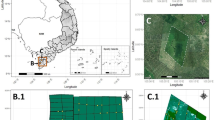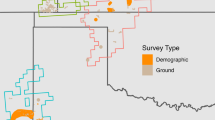Abstract
Information on population abundance is important to correctly plan conservation and management of animal populations. In general, capture-mark-recapture (CMR) is considered the most robust technique to estimate population abundance, but it is costly in terms of time and effort. Recently, binomial N-mixture models, based on counts of unmarked individuals, have been widely employed to estimate abundance. These models have limits and their reliability has been criticized. In the majority of cases, multinomial N-mixture models based on multiple observer protocols, that are hierarchical extensions of simple CMR, are applied in estimating abundance of animals with large body size, conspicuous behavior or high detection probabilities. We applied and evaluated the reliability of a multinomial N-mixture modelling approach with multiple observer data to a small and cryptic terrestrial salamander, found in different habitats where populations possess different level of detectability. Estimates obtained with multinomial N-mixture models were compared to estimates obtained with classical methods, such as removal sampling, and their reliability has also been evaluated by simulations scenarios. Our results show that multinomial N-mixture models, applied within a multiple observer framework, give reliable and robust estimates of population abundance even when detection and density are relatively low. Therefore, multinomial N-mixture models appear efficient and cost-effective when planning and identifying management actions and conservation programs of small terrestrial animals such as amphibians and reptiles.





Similar content being viewed by others
References
Ariefiandy A, Purwandana D, Seno A, Chrismiawati M, Ciofi C, Jessop TS (2014) Evaluation of three field monitoring-density estimation protocols and their relevance to Komodo dragon conservation. Biodivers Conserv 23:2473–2490
Barker RJ, Schofield MR, Link WA, Sauer JR (2017) On the reliability of N-Mixture models for count data. Biometrics 74:369–377
Blondel J, Aronson J (1999) Biology and wildlife of the Mediterranean region. Oxford University Press, Oxford
Borchers DL, Buckland ST, Stephens WE, Zucchini W (2002) Estimating animal abundance. Springer, London, UK
Bröker KCA, Hansen RG, Leonard KE, Koski WR, Heide-Jørgensen MP (2019) A comparison of image and observer based aerial surveys of narwhal. Mar Mam Sci 35:1253–1279
Bruce RC (1995) The use of temporary removal sampling in a study of population dynamics of the salamander Desmognathus monticola. Austral Ecol 20:403–412
Burnham KP, Anderson DR (2002) Model selection multimodel inference a practical information-theoretic approach. Springer, New York
Chandler RB, Royle JA, King DI (2011) Inference about density and temporary emigration in unmarked populations. Ecology 92:1429–1435
Cook RD, Jacobson JO (1979) A design for estimating visibility bias in aerial surveys. Biometrics 35:735–742
Costa A, Crovetto F, Salvidio S (2016) European plethodontid salamanders on the forest floor: local abundance is related to fine-scale environmental factors. Herpetol Conserv Biol 11:344–349
Costa A, Oneto F, Salvidio S (2019) Time-for-space substitution in N-mixture modeling and population monitoring. J Wildlife Manage 83:737–741
Duarte A, Adams MJ, Peterson JT (2018) Fitting N-mixture models to count data with unmodeled heterogeneity: Bias, diagnostics, and alternative approaches. Ecol modell 374:51–59
Ficetola GF, Barzaghi B, Melotto A, Muraro M, Lunghi E, Canedoli C, Carretero MA (2018) N-mixture models reliably estimate the abundance of small vertebrates. Sci Rep 8:10357
Fiske I, Chandler R (2011) Unmarked: an R package for fitting hierarchical models of wildlife occurrence and abundance. J Stat Softw 43:1–23
Grant EHC, Jung RE, Nichols JD, Hines JE (2005) Double-observer approach to estimating egg mass abundance of pool-breeding amphibians. Wetl Ecol Manag 13:305–320
Griffiths RA, Foster J, Wilkinson JW, Sewell D (2015) Science, statistics and surveys: a herpetological perspective. J Appl Ecol 52:1413–1417
Hone J (2008) On bias, precision and accuracy in wildlife aerial surveys. Wildl Res 35:253–257
Jiménez J, Moreno-Opo R, Carrasco M, Feliu J (2015) Estimating the abundance and habitat selection of conservation priority marsh-dwelling passerines with a double-observer approach. Ardeola 62:269–281
Jung RE, Royle JA, Sauer JR, Addison C, Rau RD, Shirk JL, Whissel JC (2005) Estimation of stream salamander (Plethodontidae, Desmognathinae and Plethodontinae) populations in Shenandoah National Park, Virginia, USA. Alytes 22:72–84
Kéry M (2018) Identifiability in N-mixture models: a large-scale screening test with bird data. Ecology 99:281–288
Kéry M, Royle JA (2016) Applied hierarchical modelling in ecology. Academic Press, Cambridge
Knape J, Arlt D, Barraquand F, Berg Å, Chevalier M, Pärt T, Ruete A, Żmihorski M (2018) Sensitivity of binomial N-mixture models to overdispersion: the importance of assessing model fit. Methods Ecol Evol 9:2102–2114
Koneff MD, Royle JA, Otto MC, Wortham JS, Bidwell JK (2008) A double-observer method to estimate detection rate during aerial waterfowl surveys. J Wildlife Manage 72:1641–1649
Langtimm CA, Dorazio RM, Stith BM, Doyle TJ (2011) New aerial survey and hierarchical model to estimate manatee abundance. J Wildlife Manage 75:399–412
Lanza B (2007) Speleomantes strinatii (Aellen). In: Lanza B, Andreone F, Bologna MA, Corti C, Razzetti E (eds) Fauna d’Italia—Amphibia. Edizioni Calderini, Bologna, pp 152–156
Leston L, Koper N, Rosa P (2015) Perceptibility of prairie songbirds using double-observer point counts. Great Plains Res. 25:53–61
Lincoln FC (1930). Calculating waterfowl abundance on the basis of banding returns. U.S. Department of Agriculture, Circular 118, Washington DC
Lindstrom L, Reeve R, Salvidio S (2010) Bayesian salamanders: analysing the demography of an underground population of the European plethodontid Speleomantes strinatii with state-space modelling. BMC Ecol 10:4
Link WA, Schofield MR, Barker RJ, Sauer JR (2018) On the robustness of N-mixture models. Ecology 99:1547–1551
MacKenzie DI, Bailey LL (2004) Assessing the fit of site-occupancy models. J Agric Biol Environ Stat 9:300–318
McDiarmid RW, Foster MS, Guyer C, Gibbons JW, Chernoff N (2012) Reptile biodiversity. Standard methods for inventorying and monitoring. University of California Press, Berkeley
Nichols JD, Conroy MJ (1996) Techniques for estimating abundance and species richness. In: Wilson DE, Russel CF, Nichols JD, Rudram R, Foster MS (eds) Measuring and monitoring biological diversity—standard methods for mammals. Smithsonian Institution Press, Washington and London, pp 177–179
Nichols JD, Hines JE, Sauer JR, Fallon F, Fallon J, Heglund PJ (2000) A double-observer approach for estimating detection probability and abundance from avian point counts. Auk 117:393–408
Petranka JW, Murray SS (2001) Effectiveness of removal sampling for determining salamander density and biomass: a case study in an Appalachian streamside community. J Herpetol 35:36–44
Priol P, Mazerolle MJ, Imbeau L, Drapeau P, Trudeau C, Ramiere J (2014) Using dynamic N-mixture models to test cavity limitation on northern flying squirrel demographic parameters using experimental nest box supplementation. Ecol Evol 4:2165–2177
Romano A, Costa A, Basile M, Raimondi R, Posillico M, Scinti Roger D, Crisci A, Piraccini R, Raia P, Matteucci G, De Cinti B (2017) Conservation of salamanders in managed forests: Methods and costs of monitoring abundance and habitat selection. Forest Ecol Manag 400:12–18
Royle JA (2004a) Generalized estimators of avian abundance from spatially replicated count survey data. Anim Biodivers Conserv 27:375–386
Royle JA (2004b) N-mixture models for estimating population size from spatially replicated counts. Biometrics 60:108–115
Royle JA, Dorazio RM (2006) Hierarchical models of animal abundance and occurrence. J Agric Biol Environ Stat 11:249–263
Salvidio S (2001) Estimating terrestrial salamander abundance in different habitats: efficiency of temporary removal methods. Herpetol Rev 32:21–24
Salvidio S (2007) Population dynamics and regulation in the cave salamander Speleomantes strinatii. Naturwissenschaften 94:396–400
Salvidio S, Lattes A, Tavano M, Melodia F, Pastorino MV (1994) Ecology of a Speleomantes ambrosii population inhabiting an artificial tunnel. Amphibia-Reptilia 15:35–45
Salvidio S, Oneto F, Ottonello D, Pastorino MV (2016) Lagged influence of North Atlantic Oscillation on population dynamics of a Mediterranean terrestrial salamander. Int J Biometeorol 60:475–480
Salvidio S, Romano A, Palumbi G, Costa A (2017) Safe caves and dangerous forests? Predation risk may contribute to salamander colonization of subterranean habitats. Sci Nat 104:20
Schmidt BR (2003) Count data, detection probabilities, and the demography, dynamics, distribution, and decline of amphibians. CR Biol 326:S119–S124
Seber GAF (1982) Estimating animal abundance and related parameters, 2nd edn. Charles Griffin and Co., London
Southwell C (1996) Estimation of population size and density when counts are incomplete. In: Wilson DE, Russel CF, Nichols JD, Rudram R, Foster MS (eds) Measuring and monitoring biological diversity—standard methods for mammals. Smithsonian Institution Press, Washington and London, pp 196–210
Specht HM, Reich HT, Iannarilli F, Edwards MR, Stapleton SP, Weegman MD, Arnold TW (2017) Occupancy surveys with conditional replicates: an alternative sampling design for rare species. Methods Ecol Evol 8:1725–1734
Veech JA, Ott JR, Troy JR (2016) Intrinsic heterogeneity in detection probability and its effect on N-mixture models. Methods Ecol Evol 7:1019–1028
Vrtiska MP, Powell LA (2011) estimates of duck breeding populations in the nebraska sandhills using double observer methodology. Waterbirds 34:96–101
White GC, Anderson DR, Burnham KP, Otis DL (1982) Capture–recapture removal methods for sampling closed populations. Los Alamos National Laboratory 8787 NERP, Los Alamos, New Mexico
Williams BK, Nichols JD, Conroy MJ (2002) Analysis and management of animal populations. Academic Press, Cambdridge
Yoccoz NG, Nichols JD, Boulinier T (2001) Monitoring of biological diversity in space and time. Trends Ecol Evol 16:446–453
Acknowledgements
The authors declare that this study did not receive any funding, nor there is any competing financial interest, that could have altered its outcome. Permits for salamander capture and temporary removal were issued by the Italian Ministry of Environment (# 2426 of 25/02/2019). We are grateful to three anonymous reviewers for their valuable comments on a previous version of the study.
Author information
Authors and Affiliations
Corresponding author
Additional information
Communicated by Clinton Jenkins.
Publisher's Note
Springer Nature remains neutral with regard to jurisdictional claims in published maps and institutional affiliations.
Electronic supplementary material
Below is the link to the electronic supplementary material.
Rights and permissions
About this article
Cite this article
Costa, A., Romano, A. & Salvidio, S. Reliability of multinomial N-mixture models for estimating abundance of small terrestrial vertebrates. Biodivers Conserv 29, 2951–2965 (2020). https://doi.org/10.1007/s10531-020-02006-5
Received:
Revised:
Accepted:
Published:
Issue Date:
DOI: https://doi.org/10.1007/s10531-020-02006-5




